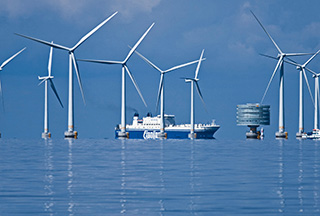Despite stalled attempts like the Cape Wind project, the U.S. has 13 offshore wind energy projects in advanced stages of development, with the potential to generate up to 6,000 MW, and developers are now trending toward deeper waters father offshore and larger turbines of 6 MW to 8 MW, according to a new report from the U.S. Energy Department.
That means future projects will site bigger machines in areas with stronger, more consistent wind speeds yielding more energy, according to the 2014-2015 U.S. Offshore Wind Technologies Market Report, prepared by the National Renewable Energy Laboratory.
Although the industry has seen “some setbacks and progress towards commercial development remains slow, policy support generally appears to be growing across the nation, which could increase demand for offshore wind power in the United States over the long term,” the report said.
The report came out Tuesday at the American Wind Energy Association Offshore Windpower Conference in Baltimore, a day after the Obama administration hosted industry leaders and regulators at the White House, and put out new plans to press forward on developing large-scale turbine arrays.
The windpower conference includes sessions on how to better integrate state and federal permitting for wind projects, building domestic supply chains and Jones Act compliant service vessels, and leveraging 20 years of European experience with offshore wind.
Led by European operators, “2015 is expected to be a record year for offshore wind deployments globally, with 3,996 MW on track to begin operations,” the NRAL report said. “In the first half of 2015, the industry commissioned 1,190 MW of this capacity, bringing the total current installed capacity to 8,990 MW worldwide. The global cumulative capacity is expected to reach 11,800 MW by year-end 2015.”
At the top of the administration’s to-do list is a new interagency working group, managed by the White House Council on Environmental Quality and Domestic Policy Council that will bring together all agencies with a role in reviewing and permitting wind projects, from the Corps of Engineers to the national Marine Fisheries Service.
“Offshore wind will play an integral role in our future energy portfolio. It is therefore critical that the federal government work with states and other key stakeholders to ensure the responsible development of this technology,” according to an administration statement announcing the new moves.
The administration claims that by 2030, offshore wind could be generating 22,000 megawatts — or enough to light up 4.5 million homes. But the first commercial project to test the viability and reliability of that vision just started this summer, with the construction of Deepwater Wind’s initial five-turbine, 30-megawatt project in Rhode Island waters.
Nevertheless, offshore wind is a pillar of the administration plan for reducing carbon emissions from power generation, with a commitment to have renewable energy resources, in addition to hydroelectric power, generating 20% of U.S. demand by 2030.
The federal Bureau of Ocean Energy Management this month moved ahead on an environmental review for potentially leasing the sea floor off North Carolina for turbine construction, and a lease offering for nearly 344,000 acres off New Jersey is now set for Nov. 9, with 13 companies qualified as bidders.
Meanwhile, BOEM has been talking with its counterpart regulators in the United Kingdom, Denmark and Germany about joining an “International Offshore Wind Regulators Forum,” where U.S. planners could tap offshore wind lessons from Europe.
Another initiative funded by the U.S. Department of Energy for $500,000 is an effort with New York, Maine, Massachusetts and Rhode Island to draw up a “regional roadmap for offshore wind,” the administration said. The latter two states harbor ambitions of becoming hub ports for offshore wind construction, and redeveloping industrial waterfronts for it at New Bedford, Mass. and Quonset Point, R.I.
“The roadmap will lay out a cooperative path to develop offshore wind at the large-scale level of deployment needed to achieve economies of scale and establish a regional supply chain with high-quality local jobs.”
Significantly, that interstate consortium leaves out New Jersey, which in 2010 passed legislation to enable offshore wind development – with a target of 1,100 mW by 2020 -- but has lagged both in implementing the law and permitting a first demonstration project of five turbines in state waters. Critics link that slacking to Gov. Chris Christie’s pursuit of the Republican presidential nomination, and need to avoid alienating primary voters and donors skeptical of renewable energy.





